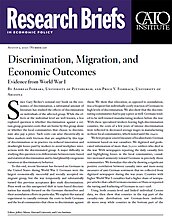To this end, recent literature has focused on Germans in the United States during World War I. Germans were the largest economically successful and socially accepted immigrant group, but the war temporarily and substantially turned this previous acceptance into stark discrimination. Prior work on this unexpected shift in taste-based discrimination has mainly focused on the Germans themselves and their assimilation efforts in particular. We exploit this natural experiment to causally estimate the costs to both Germans and the local communities that chose to discriminate against them. We show that relocation, as opposed to assimilation, was a frequent but individually costly reaction of Germans to high levels of discrimination. We also show that the discriminating communities had to pay a price as well. Germans tended to be well-trained manufacturing workers before the war. With these specialized workers leaving high-discrimination counties, the costs of a few years of intense discrimination were reflected in decreased average wages in manufacturing in those local communities, which lasted until the 1940s.
We first propose a novel measure of localized anti-German sentiment based on war casualties. We digitized and geolocated information of more than 71,000 soldiers who died in the war. With newspapers reporting the daily casualty lists and highlighting losses in the local communities, casualties increased animosity toward Germans in precisely those communities. We formalize this idea by showing a significant positive correlation between casualty rates and more-noisy measures of anti-German sentiment that we collected from digitized newspapers during the war years. Counties with higher World War I casualties had a higher share of newspaper articles that called Germans enemies or Huns or reported the tarring and feathering of Germans in 1917–1918.
Using both county-level and linked individual Census data, we then show that counties in the top part of the casualty-rate distribution saw German-born individuals move away while counties in the bottom part of the distribution saw an increase in their German population shares. This relationship between war casualties and migration patterns existed for Germans shortly before, during, and shortly after the war but not in other decades, such as the period from 1900 to 1910. The relationship also did not exist for other immigrant groups such as Swedes or Italians. Another contributing factor was salience, as the outflow of Germans was strongest in the Midwest, where Germans historically had been the largest immigrant group, and the inflow was most pronounced in the South.
The short-term costs to Germans who moved because of this casualty shock were substantial. Linked data from the 1910 and 1920 full-count Censuses for almost 150,000 German-born men show that movers were willing to relocate 585 miles on average. In 1920, they were significantly more likely to live in the South, resist naturalization, and experience an occupational downgrade before, during, or after the war. The Germans’ occupational downgrading was mainly driven by moving from nonagricultural work before the war to jobs in agriculture after the war. The occupational change toward farming may have occurred because the German-born movers mostly went South, where there was less manufacturing activity. Another advantage of becoming a farmer and living in a more rural setting was that the German-born were able to reduce the day-to-day contact with workers, employers, and customers and thus the sting of discrimination.
Anti-German discrimination and the resulting outflow of Germans had negative effects on economic growth in discriminating counties in the postwar decades until the 1940s. This was particularly true for the manufacturing sector, where Germans tended to be concentrated before the war. Using county-level Census data from 1900 to 1940, we show that counties that experienced an outflow of Germans between 1910 and 1920 saw a 1–7 percent reduction in the average annual earnings in manufacturing. The same relationship between outflows of a discriminated group and manufacturing wages did not exist for Germans from 1900 to 1910 or for other immigrant groups from 1910 to 1920, such as Swedes or Italians.
Our analysis provides a new estimate for the effects of discrimination on both the migrants and so-called sending communities by showing that it harmed the local economies through the outmigration of a relatively skilled group in response to ethnic animus. The main takeaway is that even though the discriminatory shock lasted for a few years, the economic cost of discrimination to those communities lasted for more than a decade.
NOTE:
This research brief is based on Andreas Ferrara and Price V. Fishback, “Discrimination, Migration, and Economic Outcomes: Evidence from World War I,” NBER Working Paper no. 26936, April 2020, https://www.nber.org/papers/w26936.

